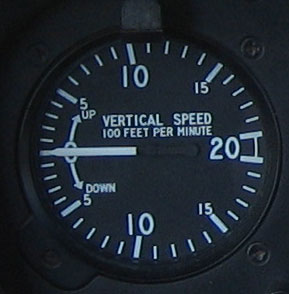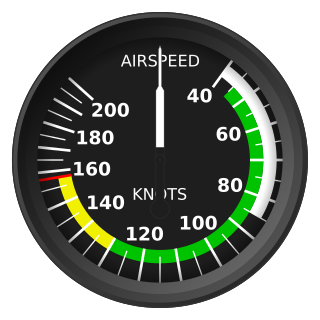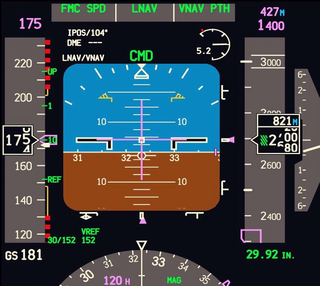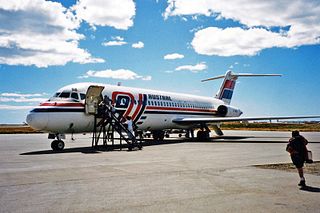
A pitottube, also known as pitot probe, is a flow measurement device used to measure fluid flow velocity. The pitot tube was invented by the French engineer Henri Pitot in the early 18th century and was modified to its modern form in the mid-19th century by French scientist Henry Darcy. It is widely used to determine the airspeed of an aircraft, water speed of a boat, and to measure liquid, air and gas flow velocities in certain industrial applications.

Flight instruments are the instruments in the cockpit of an aircraft that provide the pilot with information about the flight situation of that aircraft, such as altitude, airspeed, vertical speed, heading and much more other crucial information. They improve safety by allowing the pilot to fly the aircraft in level flight, and make turns, without a reference outside the aircraft such as the horizon. Visual flight rules (VFR) require an airspeed indicator, an altimeter, and a compass or other suitable magnetic direction indicator. Instrument flight rules (IFR) additionally require a gyroscopic pitch-bank, direction and rate of turn indicator, plus a slip-skid indicator, adjustable altimeter, and a clock. Flight into Instrument meteorological conditions (IMC) require radio navigation instruments for precise takeoffs and landings.

A variometer – also known as a rate of climb and descent indicator (RCDI), rate-of-climb indicator, vertical speed indicator (VSI), or vertical velocity indicator (VVI) – is one of the flight instruments in an aircraft used to inform the pilot of the rate of descent or climb. It can be calibrated in feet per minute, knots or metres per second, depending on country and type of aircraft. It is typically connected to the aircraft's external static pressure source.
Aviation is the design, development, production, operation, and use of aircraft, especially heavier-than-air aircraft. Articles related to aviation include:

The airspeed indicator (ASI) or airspeed gauge is a flight instrument indicating the airspeed of an aircraft in kilometers per hour (km/h), knots (kn), miles per hour (MPH) and/or meters per second (m/s). The recommendation by ICAO is to use km/h, however knots is currently the most used unit. The ASI measures the pressure differential between static pressure from the static port, and total pressure from the pitot tube. This difference in pressure is registered with the ASI pointer on the face of the instrument.

The attitude indicator (AI), formerly known as the gyro horizon or artificial horizon, is a flight instrument that informs the pilot of the aircraft orientation relative to Earth's horizon, and gives an immediate indication of the smallest orientation change. The miniature aircraft and horizon bar mimic the relationship of the aircraft relative to the actual horizon. It is a primary instrument for flight in instrument meteorological conditions.

The knot is a unit of speed equal to one nautical mile per hour, exactly 1.852 km/h. The ISO standard symbol for the knot is kn. The same symbol is preferred by the Institute of Electrical and Electronics Engineers (IEEE); kt is also common, especially in aviation, where it is the form recommended by the International Civil Aviation Organization (ICAO). The knot is a non-SI unit. Worldwide, the knot is used in meteorology, and in maritime and air navigation—for example, a vessel travelling at 1 knot along a meridian travels approximately one minute of geographic latitude in one hour.

Airspeed is the speed of an aircraft relative to the air. Among the common conventions for qualifying airspeed are indicated airspeed ("IAS"), calibrated airspeed ("CAS"), equivalent airspeed ("EAS"), true airspeed ("TAS"), and density airspeed.

The true airspeed of an aircraft is the speed of the aircraft relative to the airmass in which it is flying. The true airspeed is important information for accurate navigation of an aircraft. Traditionally it is measured using an analogue TAS indicator, but as the Global Positioning System has become available for civilian use, the importance of such analogue instruments has decreased. Since indicated airspeed is a better indicator of power used and lift available, True airspeed is not used for controlling the aircraft during taxiing, takeoff, climb, descent, approach or landing; for these purposes the Indicated airspeed – IAS or KIAS – is used. However, since indicated airspeed only shows true speed through the air at standard sea level pressure and temperature, a TAS meter is necessary for navigation purposes at cruising altitude in less dense air. The IAS meter reads very nearly the TAS at lower altitude and at lower speed. On jet airliners the TAS meter is usually hidden at speeds below 200 knots (370 km/h). Neither provides for accurate speed over the ground, since surface winds or winds aloft are not taken into account.
Indicated airspeed (IAS) is the airspeed read directly from the airspeed indicator (ASI) on an aircraft, driven by the pitot-static system. It uses the difference between total pressure and static pressure, provided by the system, to either mechanically or electronically measure dynamic pressure. The dynamic pressure includes terms for both density and airspeed. Since the airspeed indicator cannot know the density, it is by design calibrated to assume the sea level standard atmospheric density when calculating airspeed. Since the actual density will vary considerably from this assumed value as the aircraft changes altitude, IAS varies considerably from true airspeed (TAS), the relative velocity between the aircraft and the surrounding air mass. Calibrated airspeed (CAS) is the IAS corrected for instrument and position error.
Ground speed is the horizontal speed of an aircraft relative to the ground. An aircraft heading vertically would have a ground speed of zero. Information displayed to passengers through the entertainment system often gives the aircraft ground speed rather than airspeed.
Equivalent airspeed (EAS) is calibrated airspeed (CAS) corrected for the compressibility of air at a non-trivial Mach number. It is also the airspeed at sea level in the International Standard Atmosphere at which the dynamic pressure is the same as the dynamic pressure at the true airspeed (TAS) and altitude at which the aircraft is flying. In low-speed flight, it is the speed which would be shown by an airspeed indicator with zero error. It is useful for predicting aircraft handling, aerodynamic loads, stalling etc.
Calibrated airspeed (CAS) is indicated airspeed corrected for instrument and position error.
Position error is one of the errors affecting the systems in an aircraft for measuring airspeed and altitude. It is not practical or necessary for an aircraft to have an airspeed indicating system and an altitude indicating system that are exactly accurate. A small amount of error is tolerable. It is caused by the location of the static vent that supplies the altimeter.

A pitot-static system is a system of pressure-sensitive instruments that is most often used in aviation to determine an aircraft's airspeed, Mach number, altitude, and altitude trend. A pitot-static system generally consists of a pitot tube, a static port, and the pitot-static instruments. Other instruments that might be connected are air data computers, flight data recorders, altitude encoders, cabin pressurization controllers, and various airspeed switches. Errors in pitot-static system readings can be extremely dangerous as the information obtained from the pitot static system, such as altitude, is potentially safety-critical. Several commercial airline disasters have been traced to a failure of the pitot-static system.

A primary flight display or PFD is a modern aircraft instrument dedicated to flight information. Much like multi-function displays, primary flight displays are built around a Liquid-crystal display or CRT display device. Representations of older six pack or "steam gauge" instruments are combined on one compact display, simplifying pilot workflow and streamlining cockpit layouts.
In fluid mechanics the term static pressure has several uses:

A Machmeter is an aircraft pitot-static system flight instrument that shows the ratio of the true airspeed to the speed of sound, a dimensionless quantity called Mach number. This is shown on a Machmeter as a decimal fraction. An aircraft flying at the speed of sound is flying at a Mach number of one, expressed as Mach 1.

Austral Líneas Aéreas Flight 2553, also known as Austral 2553, was an Argentinian domestic, scheduled Posadas–Buenos Aires service operated with a McDonnell Douglas DC-9-32 that crashed on the lands of Estancia Magallanes, Nuevo Berlín, 32 kilometres (20 mi) away from Fray Bentos, Uruguay, on 10 October 1997. All 74 passengers and crew died upon impact. The accident remains the deadliest in Uruguayan history.

Coffin corner is the region of flight where a fast but subsonic fixed-wing aircraft's stall speed is near the critical Mach number, at a given gross weight and G-force loading. In this region of flight, it is very difficult to keep an airplane in stable flight. Because the stall speed is the minimum speed required to maintain level flight, any reduction in speed will cause the airplane to stall and lose altitude. Because the critical Mach number is the maximum speed at which air can travel over the wings without losing lift due to flow separation and shock waves, any increase in speed will cause the airplane to lose lift, or to pitch heavily nose-down, and lose altitude.












